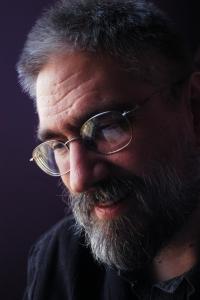Box of Fairies
By Gwen Knighton
Bedlam House, 2002
Review by Carl McColman
 The softly romantic cover illustration of the CD, replete with a half-dozen or so cute diminutive naked fairies frolicking about Gwen Knighton and her harp in a bucolic setting, might lead the listener to expect a disc full of saccharine new age melodies with insufferable affirmations strung together as lyrics. Not! The irony of the cover design is but the first trickery of this powerful and unforgettable recording filled with bardic surprises and artistic enchantment. Sure, Knighton— award-winning harpist and member of the pagan/filk trio Three Weird Sisters— is a romantic, as revealed by her reliance on fairytales as subject matter. But like all the best romantics, she's as interested in the dark as in the light, and so her debut solo recording explores a world where safety and danger rub elbows alongside the piercing longing of a stepchild as much as the sweet innocence of love between friends.
The softly romantic cover illustration of the CD, replete with a half-dozen or so cute diminutive naked fairies frolicking about Gwen Knighton and her harp in a bucolic setting, might lead the listener to expect a disc full of saccharine new age melodies with insufferable affirmations strung together as lyrics. Not! The irony of the cover design is but the first trickery of this powerful and unforgettable recording filled with bardic surprises and artistic enchantment. Sure, Knighton— award-winning harpist and member of the pagan/filk trio Three Weird Sisters— is a romantic, as revealed by her reliance on fairytales as subject matter. But like all the best romantics, she's as interested in the dark as in the light, and so her debut solo recording explores a world where safety and danger rub elbows alongside the piercing longing of a stepchild as much as the sweet innocence of love between friends. Box of Fairies is a solo album in the truest sense of the word: neither of Knighton's bandmates appear, and with the exception of bass on one song and bass and guitar on another, the rest of the album features only Knighton's harp and her voice. But this woman is a bard (never mind how much she would deny it), and like all bards she not only makes music, she enchants as well. Which means that it's easy for the listener to forget that the rich cascade of harp music and the emotional intensity of her voice are the artistry of but one person.
With the exception of a passionate reading of Leonard Cohen's "Joan of Arc," all the songs on the CD were written by Knighton. They're not pagan songs in the sense of yet-another-chant-to-Isis, but rather bardic in their exploration of a deeply lived inner world, where myth and reality collide (and collude) with varying degrees of success. While love songs like "Common Land" and "Free Fall" reveal a lyrical romanticism ably given voice by melodic tunes and confident singing, the finest and most luminous songs found here are— surprise!— the dark ones. "Ghosts" uses the metaphor of psychic ability to plumb the shadowlands of self-doubt, and "Stepchild" gazes into the world of a selkie from the forever-left-out perspective of her all-human stepdaughter, magnifying the longing for an unattainable mother's love with a similar ache for a watery world forbidden to those not born of it.
Some of the twilight tunes feature lyrics that are as funny as they are ominous: "Cinderella Sleeps" muses on the misadventures and dysfunctional lovestyles of fairy tales princesses transported into twenty-first century America, while "My Fairy Tale" takes the heroine-as-victim motif to a sardonic extreme. Humor notwithstanding, the heart of the bardic art is the telling of a story, and each song included here has its own tale, implied if not declared: such as the Arthurian backstory of "Gwen's Lullabye for Ygerna" or "Last Run," an impressionistic study of cyberpunk instincts based on the roleplaying game Shadowrun.
Musically, Knighton's compositions are "folk" in the truest sense of the word: straightforward melodies, edgy but memorable. Adorned by her fluid "harpistry," the music seduces as much as it plays. Box of Fairies reveals a world rich with mythic power. May Knighton take us there again and again.


0 Comments:
Post a Comment
<< Home